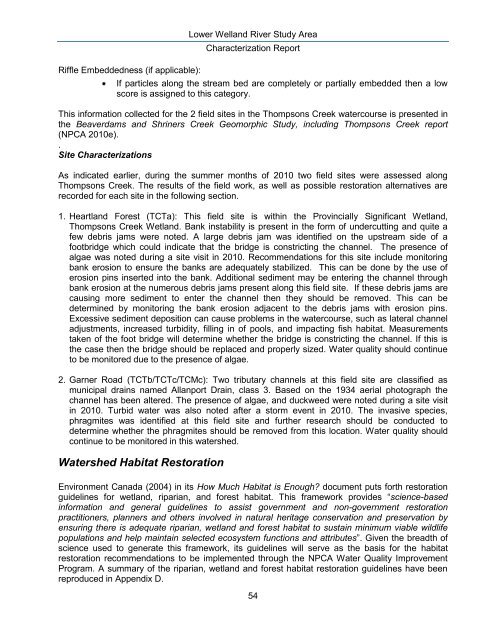Lower Welland River Characterization Report - Niagara Peninsula ...
Lower Welland River Characterization Report - Niagara Peninsula ...
Lower Welland River Characterization Report - Niagara Peninsula ...
Create successful ePaper yourself
Turn your PDF publications into a flip-book with our unique Google optimized e-Paper software.
Riffle Embeddedness (if applicable):<br />
<strong>Lower</strong> <strong>Welland</strong> <strong>River</strong> Study Area<br />
<strong>Characterization</strong> <strong>Report</strong><br />
If particles along the stream bed are completely or partially embedded then a low<br />
score is assigned to this category.<br />
This information collected for the 2 field sites in the Thompsons Creek watercourse is presented in<br />
the Beaverdams and Shriners Creek Geomorphic Study, including Thompsons Creek report<br />
(NPCA 2010e).<br />
.<br />
Site <strong>Characterization</strong>s<br />
As indicated earlier, during the summer months of 2010 two field sites were assessed along<br />
Thompsons Creek. The results of the field work, as well as possible restoration alternatives are<br />
recorded for each site in the following section.<br />
1. Heartland Forest (TCTa): This field site is within the Provincially Significant Wetland,<br />
Thompsons Creek Wetland. Bank instability is present in the form of undercutting and quite a<br />
few debris jams were noted. A large debris jam was identified on the upstream side of a<br />
footbridge which could indicate that the bridge is constricting the channel. The presence of<br />
algae was noted during a site visit in 2010. Recommendations for this site include monitoring<br />
bank erosion to ensure the banks are adequately stabilized. This can be done by the use of<br />
erosion pins inserted into the bank. Additional sediment may be entering the channel through<br />
bank erosion at the numerous debris jams present along this field site. If these debris jams are<br />
causing more sediment to enter the channel then they should be removed. This can be<br />
determined by monitoring the bank erosion adjacent to the debris jams with erosion pins.<br />
Excessive sediment deposition can cause problems in the watercourse, such as lateral channel<br />
adjustments, increased turbidity, filling in of pools, and impacting fish habitat. Measurements<br />
taken of the foot bridge will determine whether the bridge is constricting the channel. If this is<br />
the case then the bridge should be replaced and properly sized. Water quality should continue<br />
to be monitored due to the presence of algae.<br />
2. Garner Road (TCTb/TCTc/TCMc): Two tributary channels at this field site are classified as<br />
municipal drains named Allanport Drain, class 3. Based on the 1934 aerial photograph the<br />
channel has been altered. The presence of algae, and duckweed were noted during a site visit<br />
in 2010. Turbid water was also noted after a storm event in 2010. The invasive species,<br />
phragmites was identified at this field site and further research should be conducted to<br />
determine whether the phragmites should be removed from this location. Water quality should<br />
continue to be monitored in this watershed.<br />
Watershed Habitat Restoration<br />
Environment Canada (2004) in its How Much Habitat is Enough? document puts forth restoration<br />
guidelines for wetland, riparian, and forest habitat. This framework provides “science-based<br />
information and general guidelines to assist government and non-government restoration<br />
practitioners, planners and others involved in natural heritage conservation and preservation by<br />
ensuring there is adequate riparian, wetland and forest habitat to sustain minimum viable wildlife<br />
populations and help maintain selected ecosystem functions and attributes”. Given the breadth of<br />
science used to generate this framework, its guidelines will serve as the basis for the habitat<br />
restoration recommendations to be implemented through the NPCA Water Quality Improvement<br />
Program. A summary of the riparian, wetland and forest habitat restoration guidelines have been<br />
reproduced in Appendix D.<br />
54

















